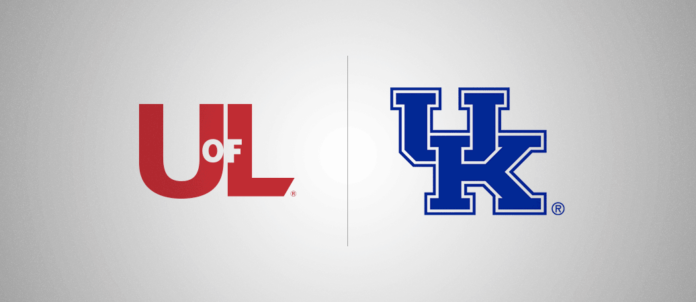
On the football field this Saturday, it will be Red versus Blue, the Cardinals battling the Wildcats, the Ville going against Big Blue Nation. The rivalry between the University of Louisville and the University of Kentucky has been called one of the most heated in collegiate sports in the nation.
But beyond the gridiron, there are numerous examples of the University of Louisville working with the University of Kentucky in research that holds promise to improve life not only for Kentuckians but for people throughout the United States and around the world.
Currently, there are 20 projects funded at a total of almost $11 million in this year alone that involve collaboration between the two universities. Agencies funding these projects include the National Institutes of Health, National Science Foundation, NASA, the Centers for Disease Control and Prevention, the Department of Transportation, the United States Geological Survey, several state agencies and more. Researchers in medicine, engineering, psychology, physics, education and the geosciences are working together to advance the body of knowledge in their fields and subfields.

“On the playing field, we are fierce competitors, but in the laboratory, we work together to bring new solutions to questions that plague our state, nation and world,” said UofL Acting President Neville Pinto, PhD. “As researchers and academicians, we put athletic rivalry aside and collaborate in research and development across a wide spectrum.”
The scope of collaboration being carried out covers a wide range of fields, from providing primary health care services and training future physicians through Area Health Education Centers across the Commonwealth to development of a paradigm-shifting therapy for humans exposed to radiation.
Other joint research is examining ways to power the Kentucky bioeconomy for a sustainable future; studying systems biochemistry with the goal of achieving a mechanistic understanding of non-small cell lung cancer; developing better ways to predict deterioration of asphalt and asphalt-overlaid concrete pavement roadways throughout the state; modeling urban watershed runoff in storm events; and more.
One example of UofL-UK collaboration is the Kentucky Multi-scale Manufacture and Nano Integration Node (KY MMNIN), one of just 16 academic sites across the United States that make up the prestigious National Nanotechnology Coordinate Infrastructure network funded by the National Science Foundation. This 10-year project funded at a total of $7 million leverages more than 25 years of expertise in the fields of micro- and nano-fabrication and three-dimensional additive manufacture, otherwise known as “3-D printing.”
The project’s principal investigator is Kevin Walsh, PhD, UofL Samuel T. Fife Endowed Professor, Electrical and Computer Engineering, and Associate Dean for Research in the J.B. Speed School of Engineering. Walsh also is a Fellow of the National Academy of Inventors.
The goal of the MMNIN project is to bring 3-D additive manufacturing and micro/nanotechnology to the invention and creative marketplace.
“The next generation of revolutionary products and solutions will require the combination and effective integration of a diverse set of 3-D manufacturing processes spanning various lengthscales ranging from nanotechnology to 3-D printing,” Walsh said. “Users want easy access to these resources and expertise to rapidly and efficiently fabricate their creative ideas.”
With both standard fabrication and 3-D additive processes, the KY MMNIN initiative provides users with unconventional and nationally unique tools to realize their inventions, Walsh said.
One such user is Angelique Johnson, PhD, a part-time lecturer in the Speed School and President/CEO of MEMStim LLC. Johnson’s company is developing ways to improve and lower the cost of cochlear implants for people who are deaf.
Johnson’s Louisville-based start-up uses advanced manufacturing to fabricate cochlear implants in the Cardinal cleanroom, a controlled manufacturing facility that is one of the eight facilities of the KY MMNIN.
The complex circuitry in cochlear implants currently must be manufactured by hand, leading to higher costs. Johnson believes that if she can improve the manufacturing process, she could then lower the cost of cochlear implants and allow more people in need of implants to afford them.
Johnson is using a machine-driven process to reduce the need for costly handmade manufacturing of implant circuitry. Using the diverse toolset of the KY MMNIN cleanroom, Johnson can design different features on the electrode arrays needed for cochlear implants. Her process has never been done before in the manufacture of these types of devices. Her circuitry for cochlear implants is still in the testing phase with the goal of one day achieving FDA approval for use in humans.
“Being able to improve the technology is my motivation to improve the quality of life for patients,” she said.
Currently, more than 40 percent of published studies in leading journals are collaborative in nature. Research funding favors collaboration as well; both government agencies and private foundations have increasingly structured requests for proposals to favor collaboration.
































